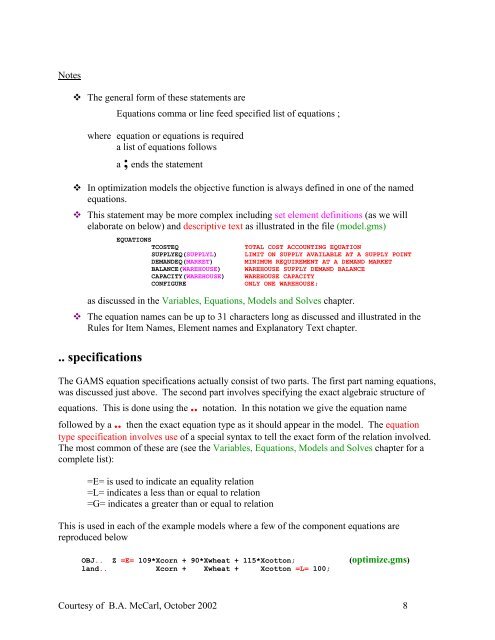You also want an ePaper? Increase the reach of your titles
YUMPU automatically turns print PDFs into web optimized ePapers that Google loves.
Notes<br />
The general form of these statements are<br />
Equations comma or line feed specified list of equations ;<br />
where equation or equations is required<br />
a list of equations follows<br />
a ; ends the statement<br />
In optimization models the objective function is always defined in one of the named<br />
equations.<br />
This statement may be more complex including set element definitions (as we will<br />
elaborate on below) and descriptive text as illustrated in the file (model.gms)<br />
EQUATIONS<br />
TCOSTEQ TOTAL COST ACCOUNTING EQUATION<br />
SUPPLYEQ(SUPPLYL) LIMIT ON SUPPLY AVAILABLE AT A SUPPLY POINT<br />
DEMANDEQ(MARKET) MINIMUM REQUIREMENT AT A DEMAND MARKET<br />
BALANCE(WAREHOUSE) WAREHOUSE SUPPLY DEMAND BALANCE<br />
CAPACITY(WAREHOUSE) WAREHOUSE CAPACITY<br />
CONFIGURE ONLY ONE WAREHOUSE;<br />
as discussed in the Variables, Equations, Models and Solves chapter.<br />
The equation names can be up to 31 characters long as discussed and illustrated in the<br />
Rules for Item Names, Element names and Explanatory Text chapter.<br />
.. specifications<br />
The GAMS equation specifications actually consist of two parts. The first part naming equations,<br />
was discussed just above. The second part involves specifying the exact algebraic structure of<br />
equations. This is done using the .. notation. In this notation we give the equation name<br />
followed by a .. then the exact equation type as it should appear in the model. The equation<br />
type specification involves use of a special syntax to tell the exact form of the relation involved.<br />
The most common of these are (see the Variables, Equations, Models and Solves chapter for a<br />
complete list):<br />
=E= is used to indicate an equality relation<br />
=L= indicates a less than or equal to relation<br />
=G= indicates a greater than or equal to relation<br />
This is used in each of the example models where a few of the component equations are<br />
reproduced below<br />
OBJ.. Z =E= 109*Xcorn + 90*Xwheat + 115*Xcotton; (optimize.gms)<br />
land.. Xcorn + Xwheat + Xcotton =L= 100;<br />
Courtesy of B.A. McCarl, October 2002 8
















